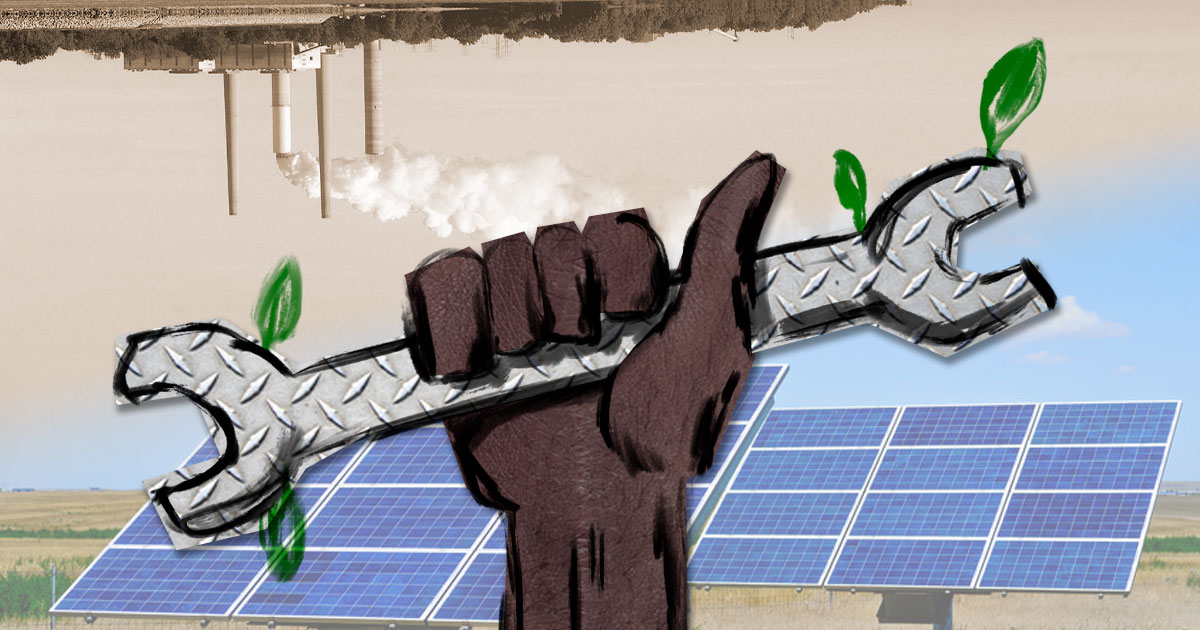
As debates over the climate crisis and the proposed “Green New Deal” unfold, veteran activist and writer Tom Wetzel speaks to its short comings and proposes an eco-syndicalist alternative. Read the second part, “The Syndicalist Alternative for an Eco-socialist Future.” This first appeared in Ideas & Action.
By Tom Wetzel
Capitalist dynamics are at the very heart of the current crisis that humanity faces over global warming.
When we talk of “global warming,” we’re talking about the rapid — and on-going — rise in the average world-wide surface and ocean temperature. Thus far a rise of 0.8 degrees Celsius (1.4 degrees Fahrenheit) since 1880. According to an ongoing temperature analysis conducted by scientists at NASA’s Goddard Institute for Space Studies, two-thirds of this temperature increase has occurred since 1975. A one-degree rise in temperature might seem like no big deal. As the NASA scientists point out, however, “A one-degree global change is significant because it takes a vast amount of heat to warm all the oceans, atmosphere, and land by that much.”
We know that carbon dioxide emissions from the burning of fossil fuels is at the heart of the problem. For many centuries the proportion of carbon dioxide in the atmosphere ranged between 200 and 300 parts per million. By the 1950s the growth of industrial capitalism since the 1800s had pushed this to the top of this range — 310 parts per million. Since then the concentration of carbon dioxide in the atmosphere has risen very rapidly — to more than 410 parts per million by 2018. This is the result of the vast rise in the burning of fossil fuels in the era since World War II — coal, petroleum, natural gas.
Shifting the Cost of Disaster
The problem is rooted in the very structure of capitalism itself. Cost-shifting is an essential feature of the capitalist mode of production. An electric power company burns coal to generate electricity because the price per kilowatt hour from coal-fired electricity has long been cheaper than alternatives. But the emissions from burning coal travel downwind and cause damage to the respiratory systems of thousands of people — including preventable deaths to people with respiratory ailments. This is in addition to the powerful contribution to global warming from the carbon dioxide emissions. But the power firm doesn’t have to pay money for these human costs. If the firm had to pay fees that would be equivalent to the human cost in death, respiratory damage and contribution to global warming and its effects, burning coal would not be profitable for the power company.
Firms also externalize costs onto workers, such as the health effects of stress or chemical exposures. The “free market” pundit or hack economist might deny that companies externalize costs onto workers. They might say that wages and benefits paid to workers for each hour of work measure the cost of labor. But the human cost of work can be increased without an increase in the compensation paid to workers. If a company speeds up the pace of work, if people are working harder, if they are more tightly controlled by supervisors, paced by machines or software, this increases the cost in human terms.
Toxic chemicals used in manufacturing, in agriculture and other industries pose a threat to both the workers and to people who live in nearby areas. Usually working class people live in neighborhoods near polluting industries, and often these are communities of color. This is another form of capitalist cost-shifting.
State regulation of pesticides or air pollution often ends up acting as a “cover” for the profit-making firms. Despite the existence of pollutants generated by leaky oil refineries and pollutants emitted by other industries in industrial areas in California — such as the “cancer alley” of oil refineries in the Contra Costa County area or the similar refinery zone in Wilmington — the government agencies set up to deal with air pollution in the Bay Area and Los Angeles County protected polluters for years by focusing almost exclusively on pollution generated by vehicle exhaust. In this way the South Coast Air Quality Management District and the Bay Area Air Quality Management District have been an example of “regulatory capture” by corporate capital.
Power firms that generate vast amounts of carbon dioxide emissions — and firms that make profits from building fossil-fuel burning cars and trucks or from the sale of gasoline and diesel and jet fuel — have not had to pay fees or penalties for the growing build up of the carbon dioxide layer in the atmosphere. The global warming crisis thus has its explanation in cost shifting and the search for short-term profits and ever growing markets — features that are at the heart of the capitalist system.
If global capitalism continues with “business as usual,” the warming will have major impacts — killer heat waves, more ocean heat pumping energy into hurricanes and cyclones, rising ocean levels from melting of ice in the polar regions and melting of glaciers, destruction of corals in the oceans, and a greater danger to the survival of many species of living things.
Previous attempts to get global agreement to cut back burning of fossil fuels have been ineffective. The Paris accords merely proposed voluntary targets. NASA scientist James Hansen described it as a “fraud”: “There is no action, just promises.” According to the UN Intergovernmental Panel on Climate Change, the dire situation calls for “rapid and far-reaching transitions…unprecedented in terms of scale.” The IPCC warns that there needs to be a 45 percent world-wide reduction in the production of heat-trapping gases (mainly carbon dioxide) by 2030 if humanity is to avoid dangerous levels of global warming.
The Origins and Goals of the “Green New Deal”
Clearly a global change is needed. But how to bring this about?
The concept of a Green New Deal has been proposed by Green Party activists, climate justice groups and various radicals for some time. The slogan is based on a comparison with the statist planning used by President Roosevelt to respond to the economic crisis of the 1930s as well as the vast and rapid transition of American industry to war production at the beginning of World War II. The idea is that the crisis of global warming should be treated with equal urgency as the mass unemployment of 1933 or the fascist military threat of the early 1940s.
After the election to Congress of Alexandria Ocasio-Cortez — a member of Democratic Socialists of America — the Green New Deal resolution was introduced into the US Congress by Ocasio-Cortez and Senator Ed Markey. This lays out a set of ambitious goals, such as 100 percent electric power generation in the USA from “clean, renewable, and zero-emission energy sources.”
Other goals include “removing pollution and greenhouse gas emissions from manufacturing…as much as is technologically feasible” and “overhauling” the transport sector “to eliminate pollution and greenhouse gas emissions” from transport “through investment in zero-emission vehicles, accessible public transportation and high speed rail.” Along with this resolution, a letter was sent to the US Congress from 626 environmental organizations backing the Green New Deal proposal. These environmental groups made it quite clear they oppose any market-based tinkering — reforms that we know won’t work — such as “cap and trade” (trading in pollution “rights”).
Many have proposed “public-private partnerships” and public subsidies to private corporations. Robert Pollin, writing in New Left Review, talks about “preferential tax treatment for clean-energy investments” and “market arrangements through government procurement contracts.” All part of a so-called “green industrial policy.” A green capitalism, in other words.
But workers are often skeptical of these promises. Companies will simply lay people off, under-pay them, or engage in speed-up and dangerous work practices — if they can profit by doing so. For example, low pay, work intensification and injuries have been a problem at the Tesla electric car factory which has received 5 billion dollars in government subsidies. Tesla recently laid off 7 percent of its workforce (over three thousand workers) in pursuit of profitability.
An alternative approach that looks to statist central planning has been proposed by Richard Smith — an eco-socialist who is also a member of Democratic Socialists of America. Smith characterizes the proposal by Alexandria Ocasio-Cortez this way:
Ocasio-Cortez…is a bold, feminist, anti-racist and socialist-inspired successor to FDR…She’s taking the global warming discussion to a new level…She’s not calling for cap and trade or carbon taxes or divestment or other “market” solutions. She’s issuing a full-throated call for de-carbonization — in effect throwing the gauntlet down to capitalism and challenging the system…
Smith believes the goals of the Green New Deal can’t be realized through things like “incentives” — and he’s right about that. He points out that the Green New Deal resolution “lacks specifics” about how the goals will be reached. To realize the goal of “de-carbonizing” the economy, he proposes a three-part program:
- Declare a state of emergency to suppress fossil fuel use. Ban all new extraction. Nationalize the fossil fuel industry to phase it out.
- Create a federal program in the style of the 1930s Works Progress Administration to shift the workforce of the shut-down industries to “useful but low emissions” areas of the economy “at equivalent pay and benefits.”
- Launch a “state-directed” crash program to phase in renewable electric power production, electric transport vehicles and other methods of transport not based on burning fossil fuels. Develop programs to shift from petro-chemical intensive industrial agriculture to organic farming.
Even though “AOC explicitly makes a powerful case for state planning,” Smith says, a weakness of the Green New Deal resolution, from his perspective, is the failure to “call for a National Planning Board to reorganize, reprioritize and restructure the economy.” When he talks about nationalization, he notes “We do not call for expropriation.” He’s talking about buying out the shareholders at “fair market value.” This is essentially a proposal for a largely state-directed form of capitalist economy — a form of state capitalism.
Smith’s proposal is wildly unrealistic. Are we to believe that the corporate-media influenced American electoral scheme can be used to elect politicians — through the business-controlled Democratic Party — to enact a multi-trillion dollar program of seizures of the fossil fuel industry, auto manufacturers, and chemical firms and set up a planning board to direct the economy?
Romanticizing the 1930s New Deal
The American working class did make important gains in the Thirties — such as the Fair Labor Standards Act (minimum wage, unemployment insurance) and Aid to Families with Dependent Children. These concessions were only won due to an uprising of the American working class in a context of vast struggles around the world — a working class revolution in Spain, plant occupations in France, a communist insurgency in China, the Communists holding on in Russia. In that moment capitalism faced a threat to its very existence.
The USA saw a huge working class rebellion between 1933 and 1937 — millions of workers on strike, hundreds of thousands of workers creating new unions from scratch, rising influence for revolutionary organizations, a thousand workplace seizures (sit-down strikes), challenges to Jim Crow in the south. And in 1936 this angry and militant mood also pushed very close to the formation of a national Farmer-Labor Party that would have been a major threat to the Democrats. Many formerly intransigent corporations were forced to negotiate agreements with unions. The Democrats chose to “move left” in that moment.
It’s also a mistake to romanticize the New Deal. People talk of the 1930s WPA as the model for “job guarantees” — that is, government as employer of last resort. But there was still 17 percent unemployment in USA as late as 1940. Workers in the WPA often had beefs such as low pay. Communists, socialists and syndicalists organized unions and strikes among WPA workers. The gains that working class people were able to win in the Thirties did not simply come about through electoral politics. Nor were the conservative, bureaucratic “international unions” of the American Federal of Labor the vehicle either. They were more of a road block — exactly why several hundred thousand workers had created new grassroots unions from scratch by late 1934.
Smith is not alone in pushing statist central planning as a solution. This concept is being talked up lately by various state socialists — including people associated with Jacobin magazine and DSA. These advocates often assume the state is simply a class-neutral institution that could be taken hold of by the working class and wielded for its purposes.
In reality the state is not class-neutral but has class oppression built into its very structure. For example, public sector workers are subordinate to managerialist bureaucracies just as workers are in the private corporations. The day-to-day workings of state institutions are controlled by the cadres of the bureaucratic control class — state managers, high end professionals employed as experts, prosecutors and judges, military and police brass. This is in addition to the “professionals of representation” — the politicians — who are typically drawn from either the business or bureaucratic control classes, that is, classes to which working class people are subordinate.
As a top-down approach to planning, statist central planning has no way to gain accurate information about either public preferences for public goods and services or individual consumer preferences. Statist central planning is also inherently authoritarian. This is because it is based on a denial of self-management to people who would be primarily affected by its decisions — consumers and residents of communities, on the one hand, and workers in the various industries who would continue to be subject to managerialist autocracy.

Self-Managed Solutions to the Crisis
Self-management means that people who are affected by decisions have control over those decisions to the extent they are affected. There are many decisions in the running of workplaces where the group who are primarily affected are the workers whose activity makes up the production process. Taking self-management seriously would require a form of distributed control in planning, where groups who are primarily affected over certain decisions — such as residents of local communities or workers in industries— have an independent sphere of decision-making control. This is the basis of the syndicalist alternative of distributed planning, discussed below.
State socialists will sometimes make noises about “worker control” as an element of central planning, but real collective power of workers over the production process is inconsistent with the concept of central planning. If planning is to be the activity of an elite group at a center, they will want to have their own managers on site in workplaces to make sure their plans are carried out. Any talk of “worker control” always loses out to this logic.
Statist central planning can’t overcome either the exploitative or cost-shifting logic of capitalism, which lies at the heart of the ecological crisis. Various populations are directly impacted by pollution in various forms — such as the impact of pesticide pollution on farm workers and rural communities or the impact on air and water in various communities. The only way to overcome the cost-shifting logic is for the affected populations — workers and communities — to gain direct power to prevent being polluted on. For global warming, this means the population in general needs a direct form of popular power that would enable the people to directly control the allowable emissions into the atmosphere.
As difficult as it may be, we need a transition to a self-managed, worker-controlled socialist political economy if we’re going to have a solution to the ecological crisis of the present era. But this transition can only really come out of the building up of a powerful, participatory movement of the oppressed majority in the course of struggles against the present regime.

Tom Wetzel is active with Worker’s Solidarity Alliance (WSA) in the San Francisco Bay Area and has organized around housing and transit issues in San Francisco. This piece was originally published in Ideas & Action, the online publication of the WSA.
For more writings by Tom Wetzel we recommend a review of the classic work, “For Workers Power” by Maurice Brinton, or “Workers Power and the Spanish Revolution.”
For more writings related to ecology issues we recommend “A Green New Deal vs. Revolutionary Ecosocialism” and “The State Against Climate Change: Response to Christian Parenti.”
